Fair Value Accounting, Enron Scandal, and Boral Limited Analysis
VerifiedAdded on 2023/06/05
|11
|2664
|155
Case Study
AI Summary
This case study delves into the complexities of fair value accounting (FVA), contrasting it with traditional historical cost accounting methods. It examines the Enron scandal, where FVA was controversially used to inflate profits from long-term contracts, facilitated by special purpose entities (SPEs) that concealed the company's debt. The case study also explores the agency relationship between top management and the organization, highlighting how stock option schemes at Enron incentivized executives to prioritize personal gain over the company's interests. Furthermore, the analysis extends to Boral Limited, an Australian company, reviewing its financial reporting practices, particularly its adherence to International Accounting Standards Board (IASB) guidelines, and its valuation methods for assets and liabilities, including the use of historical cost and fair value accounting for different financial elements.
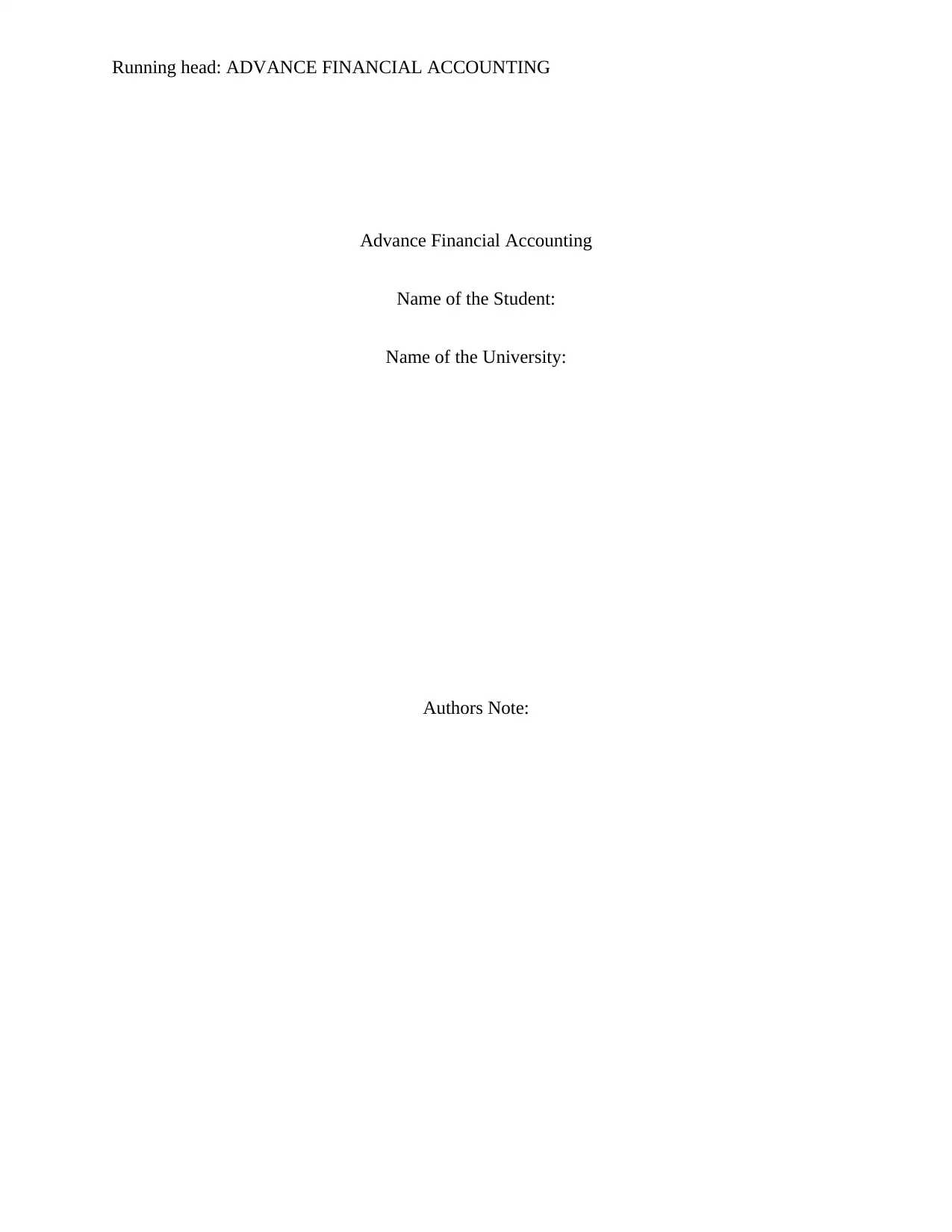
Running head: ADVANCE FINANCIAL ACCOUNTING
Advance Financial Accounting
Name of the Student:
Name of the University:
Authors Note:
Advance Financial Accounting
Name of the Student:
Name of the University:
Authors Note:
Paraphrase This Document
Need a fresh take? Get an instant paraphrase of this document with our AI Paraphraser
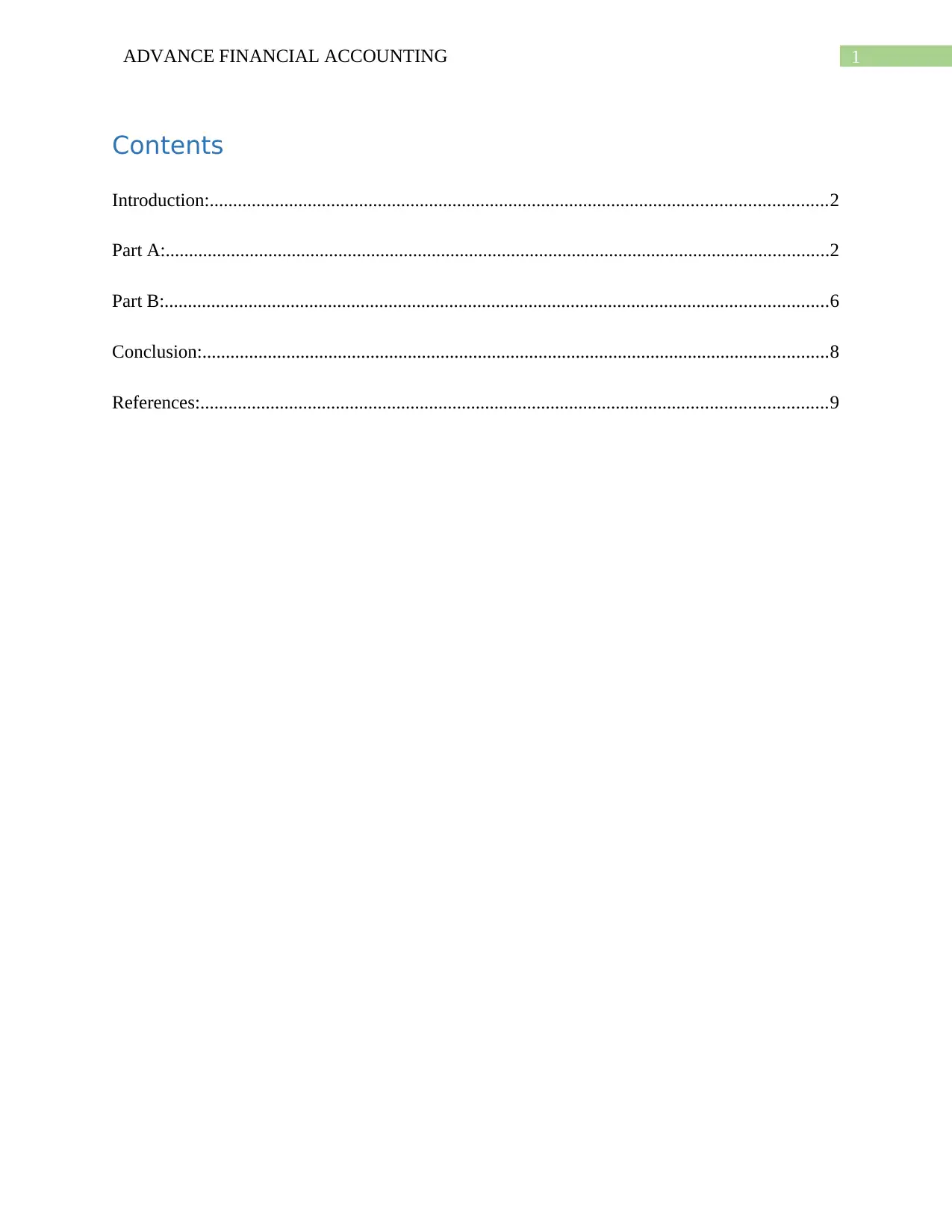
1ADVANCE FINANCIAL ACCOUNTING
Contents
Introduction:....................................................................................................................................2
Part A:..............................................................................................................................................2
Part B:..............................................................................................................................................6
Conclusion:......................................................................................................................................8
References:......................................................................................................................................9
Contents
Introduction:....................................................................................................................................2
Part A:..............................................................................................................................................2
Part B:..............................................................................................................................................6
Conclusion:......................................................................................................................................8
References:......................................................................................................................................9
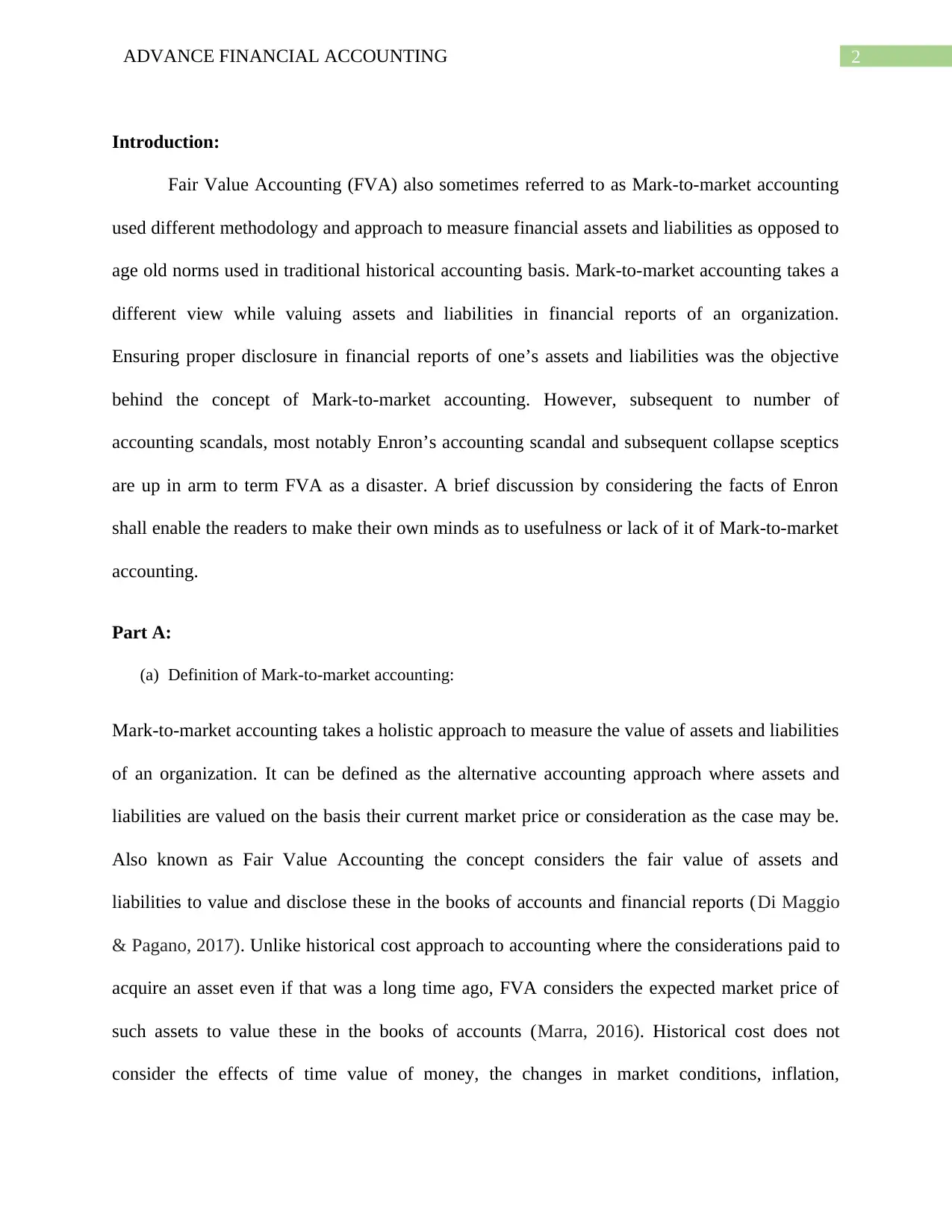
2ADVANCE FINANCIAL ACCOUNTING
Introduction:
Fair Value Accounting (FVA) also sometimes referred to as Mark-to-market accounting
used different methodology and approach to measure financial assets and liabilities as opposed to
age old norms used in traditional historical accounting basis. Mark-to-market accounting takes a
different view while valuing assets and liabilities in financial reports of an organization.
Ensuring proper disclosure in financial reports of one’s assets and liabilities was the objective
behind the concept of Mark-to-market accounting. However, subsequent to number of
accounting scandals, most notably Enron’s accounting scandal and subsequent collapse sceptics
are up in arm to term FVA as a disaster. A brief discussion by considering the facts of Enron
shall enable the readers to make their own minds as to usefulness or lack of it of Mark-to-market
accounting.
Part A:
(a) Definition of Mark-to-market accounting:
Mark-to-market accounting takes a holistic approach to measure the value of assets and liabilities
of an organization. It can be defined as the alternative accounting approach where assets and
liabilities are valued on the basis their current market price or consideration as the case may be.
Also known as Fair Value Accounting the concept considers the fair value of assets and
liabilities to value and disclose these in the books of accounts and financial reports (Di Maggio
& Pagano, 2017). Unlike historical cost approach to accounting where the considerations paid to
acquire an asset even if that was a long time ago, FVA considers the expected market price of
such assets to value these in the books of accounts (Marra, 2016). Historical cost does not
consider the effects of time value of money, the changes in market conditions, inflation,
Introduction:
Fair Value Accounting (FVA) also sometimes referred to as Mark-to-market accounting
used different methodology and approach to measure financial assets and liabilities as opposed to
age old norms used in traditional historical accounting basis. Mark-to-market accounting takes a
different view while valuing assets and liabilities in financial reports of an organization.
Ensuring proper disclosure in financial reports of one’s assets and liabilities was the objective
behind the concept of Mark-to-market accounting. However, subsequent to number of
accounting scandals, most notably Enron’s accounting scandal and subsequent collapse sceptics
are up in arm to term FVA as a disaster. A brief discussion by considering the facts of Enron
shall enable the readers to make their own minds as to usefulness or lack of it of Mark-to-market
accounting.
Part A:
(a) Definition of Mark-to-market accounting:
Mark-to-market accounting takes a holistic approach to measure the value of assets and liabilities
of an organization. It can be defined as the alternative accounting approach where assets and
liabilities are valued on the basis their current market price or consideration as the case may be.
Also known as Fair Value Accounting the concept considers the fair value of assets and
liabilities to value and disclose these in the books of accounts and financial reports (Di Maggio
& Pagano, 2017). Unlike historical cost approach to accounting where the considerations paid to
acquire an asset even if that was a long time ago, FVA considers the expected market price of
such assets to value these in the books of accounts (Marra, 2016). Historical cost does not
consider the effects of time value of money, the changes in market conditions, inflation,
⊘ This is a preview!⊘
Do you want full access?
Subscribe today to unlock all pages.

Trusted by 1+ million students worldwide
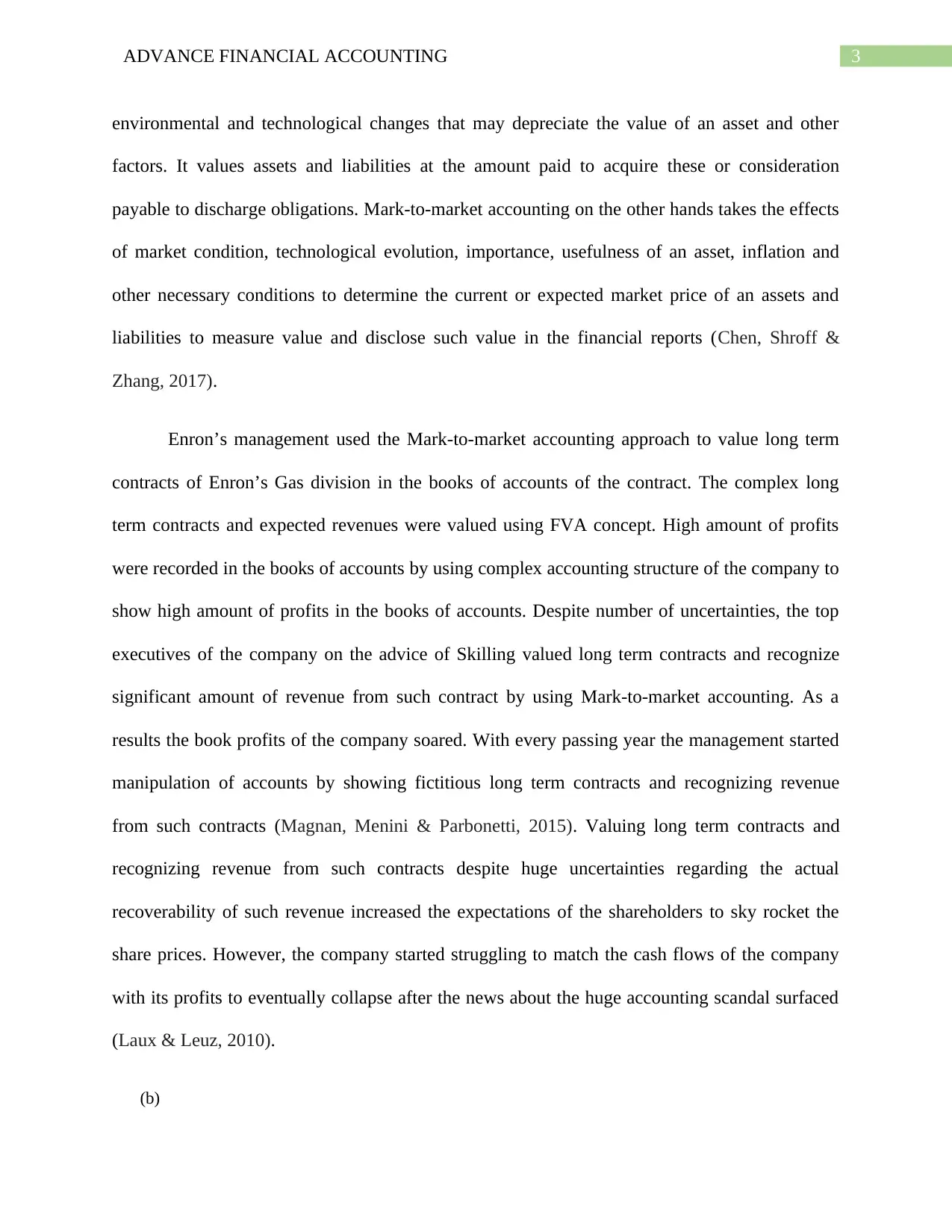
3ADVANCE FINANCIAL ACCOUNTING
environmental and technological changes that may depreciate the value of an asset and other
factors. It values assets and liabilities at the amount paid to acquire these or consideration
payable to discharge obligations. Mark-to-market accounting on the other hands takes the effects
of market condition, technological evolution, importance, usefulness of an asset, inflation and
other necessary conditions to determine the current or expected market price of an assets and
liabilities to measure value and disclose such value in the financial reports (Chen, Shroff &
Zhang, 2017).
Enron’s management used the Mark-to-market accounting approach to value long term
contracts of Enron’s Gas division in the books of accounts of the contract. The complex long
term contracts and expected revenues were valued using FVA concept. High amount of profits
were recorded in the books of accounts by using complex accounting structure of the company to
show high amount of profits in the books of accounts. Despite number of uncertainties, the top
executives of the company on the advice of Skilling valued long term contracts and recognize
significant amount of revenue from such contract by using Mark-to-market accounting. As a
results the book profits of the company soared. With every passing year the management started
manipulation of accounts by showing fictitious long term contracts and recognizing revenue
from such contracts (Magnan, Menini & Parbonetti, 2015). Valuing long term contracts and
recognizing revenue from such contracts despite huge uncertainties regarding the actual
recoverability of such revenue increased the expectations of the shareholders to sky rocket the
share prices. However, the company started struggling to match the cash flows of the company
with its profits to eventually collapse after the news about the huge accounting scandal surfaced
(Laux & Leuz, 2010).
(b)
environmental and technological changes that may depreciate the value of an asset and other
factors. It values assets and liabilities at the amount paid to acquire these or consideration
payable to discharge obligations. Mark-to-market accounting on the other hands takes the effects
of market condition, technological evolution, importance, usefulness of an asset, inflation and
other necessary conditions to determine the current or expected market price of an assets and
liabilities to measure value and disclose such value in the financial reports (Chen, Shroff &
Zhang, 2017).
Enron’s management used the Mark-to-market accounting approach to value long term
contracts of Enron’s Gas division in the books of accounts of the contract. The complex long
term contracts and expected revenues were valued using FVA concept. High amount of profits
were recorded in the books of accounts by using complex accounting structure of the company to
show high amount of profits in the books of accounts. Despite number of uncertainties, the top
executives of the company on the advice of Skilling valued long term contracts and recognize
significant amount of revenue from such contract by using Mark-to-market accounting. As a
results the book profits of the company soared. With every passing year the management started
manipulation of accounts by showing fictitious long term contracts and recognizing revenue
from such contracts (Magnan, Menini & Parbonetti, 2015). Valuing long term contracts and
recognizing revenue from such contracts despite huge uncertainties regarding the actual
recoverability of such revenue increased the expectations of the shareholders to sky rocket the
share prices. However, the company started struggling to match the cash flows of the company
with its profits to eventually collapse after the news about the huge accounting scandal surfaced
(Laux & Leuz, 2010).
(b)
Paraphrase This Document
Need a fresh take? Get an instant paraphrase of this document with our AI Paraphraser

4ADVANCE FINANCIAL ACCOUNTING
Special Purpose Entities (SPEs) are created legally under the respective corporations of act of
different countries, for example under the Corporations Act, 2001 in Australia. SPEs can be
defined as the fenced entity created to safeguard the interest of the mother organization.
Fulfilment of narrow and small objectives is the main purpose of creation SPEs.
Enron’s Management in order hide the debts of the company created more than 100 Special
Purpose Entities (SPEs). The sole objective of creating more than 100 SPEs is to paint a rosy
picture of the mother entity, i.e. Enron’s by transferring the debts to these SPEs. The objective of
financial reporting is to show the true and far picture of financial performance and position of an
organization as at the end of the period to which such statements relate. However, when the
management uses legal means such as creation of SPEs just to hide the debts and obligations of
the mother entity to portray a better picture of it than its actual picture then the whole exercise of
financial reporting becomes fruitless. Enron’s management manipulate the accounts to paint a
rosy picture of the organization to fund contracts and financial reporting objectives of window
dressing the financial statements of the company (Arnold, 2009).
(c)
The relationship between the top management and the organization is that of agency and
principle. The Board of directors in case of a company and other such bodies in case of different
forms of organizations have responsibility to conduct the affairs of the organization in a way
most suitable to the organization. Ensuring fulfilment of the objectives of the organization is on
the shoulder of the management and it must manage the affairs of the organization keeping in
mind the objectives (Acharya & Richardson, 2009). Agency theory is based on the premise that
the agent of an organization will act on behalf of the principal and keeping the interests of the
Special Purpose Entities (SPEs) are created legally under the respective corporations of act of
different countries, for example under the Corporations Act, 2001 in Australia. SPEs can be
defined as the fenced entity created to safeguard the interest of the mother organization.
Fulfilment of narrow and small objectives is the main purpose of creation SPEs.
Enron’s Management in order hide the debts of the company created more than 100 Special
Purpose Entities (SPEs). The sole objective of creating more than 100 SPEs is to paint a rosy
picture of the mother entity, i.e. Enron’s by transferring the debts to these SPEs. The objective of
financial reporting is to show the true and far picture of financial performance and position of an
organization as at the end of the period to which such statements relate. However, when the
management uses legal means such as creation of SPEs just to hide the debts and obligations of
the mother entity to portray a better picture of it than its actual picture then the whole exercise of
financial reporting becomes fruitless. Enron’s management manipulate the accounts to paint a
rosy picture of the organization to fund contracts and financial reporting objectives of window
dressing the financial statements of the company (Arnold, 2009).
(c)
The relationship between the top management and the organization is that of agency and
principle. The Board of directors in case of a company and other such bodies in case of different
forms of organizations have responsibility to conduct the affairs of the organization in a way
most suitable to the organization. Ensuring fulfilment of the objectives of the organization is on
the shoulder of the management and it must manage the affairs of the organization keeping in
mind the objectives (Acharya & Richardson, 2009). Agency theory is based on the premise that
the agent of an organization will act on behalf of the principal and keeping the interests of the
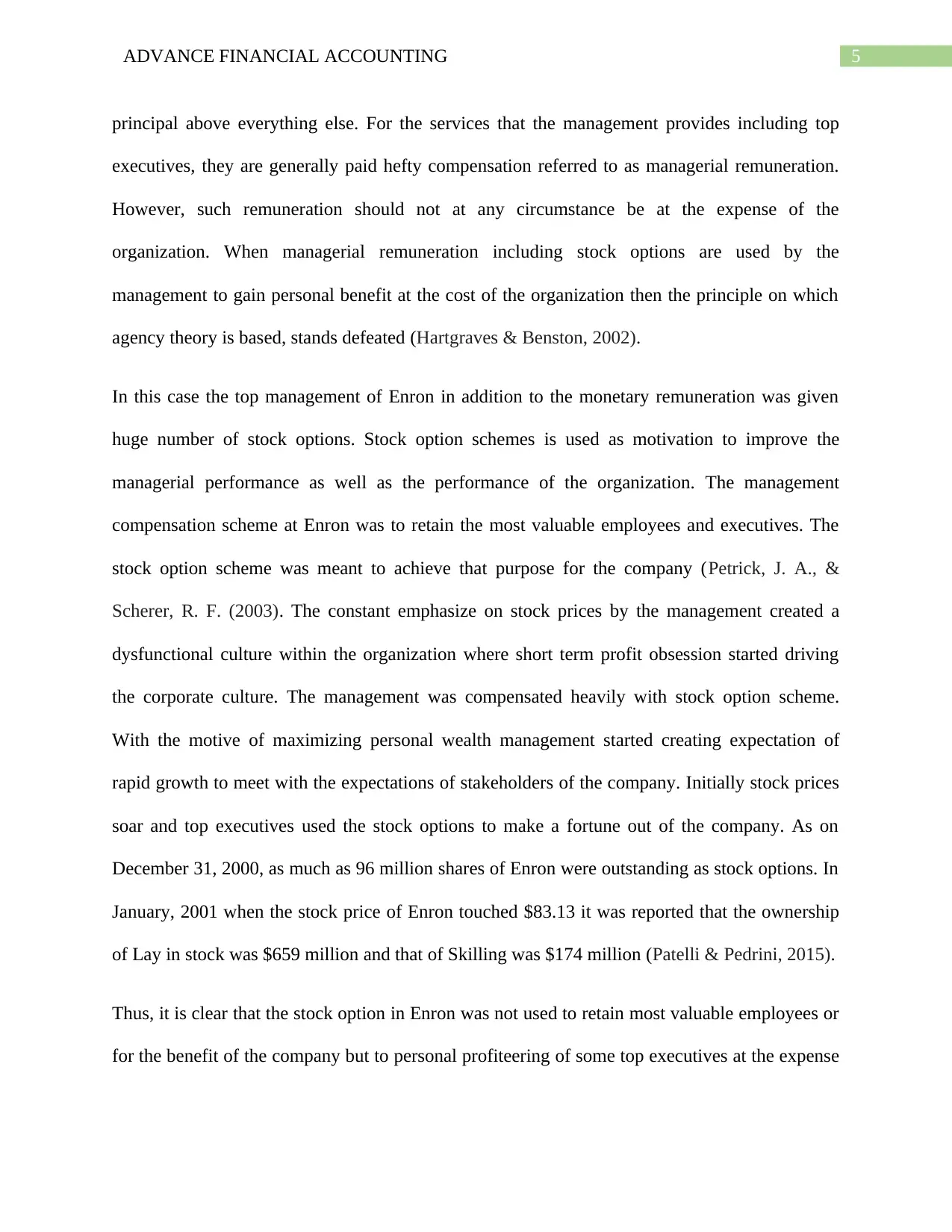
5ADVANCE FINANCIAL ACCOUNTING
principal above everything else. For the services that the management provides including top
executives, they are generally paid hefty compensation referred to as managerial remuneration.
However, such remuneration should not at any circumstance be at the expense of the
organization. When managerial remuneration including stock options are used by the
management to gain personal benefit at the cost of the organization then the principle on which
agency theory is based, stands defeated (Hartgraves & Benston, 2002).
In this case the top management of Enron in addition to the monetary remuneration was given
huge number of stock options. Stock option schemes is used as motivation to improve the
managerial performance as well as the performance of the organization. The management
compensation scheme at Enron was to retain the most valuable employees and executives. The
stock option scheme was meant to achieve that purpose for the company (Petrick, J. A., &
Scherer, R. F. (2003). The constant emphasize on stock prices by the management created a
dysfunctional culture within the organization where short term profit obsession started driving
the corporate culture. The management was compensated heavily with stock option scheme.
With the motive of maximizing personal wealth management started creating expectation of
rapid growth to meet with the expectations of stakeholders of the company. Initially stock prices
soar and top executives used the stock options to make a fortune out of the company. As on
December 31, 2000, as much as 96 million shares of Enron were outstanding as stock options. In
January, 2001 when the stock price of Enron touched $83.13 it was reported that the ownership
of Lay in stock was $659 million and that of Skilling was $174 million (Patelli & Pedrini, 2015).
Thus, it is clear that the stock option in Enron was not used to retain most valuable employees or
for the benefit of the company but to personal profiteering of some top executives at the expense
principal above everything else. For the services that the management provides including top
executives, they are generally paid hefty compensation referred to as managerial remuneration.
However, such remuneration should not at any circumstance be at the expense of the
organization. When managerial remuneration including stock options are used by the
management to gain personal benefit at the cost of the organization then the principle on which
agency theory is based, stands defeated (Hartgraves & Benston, 2002).
In this case the top management of Enron in addition to the monetary remuneration was given
huge number of stock options. Stock option schemes is used as motivation to improve the
managerial performance as well as the performance of the organization. The management
compensation scheme at Enron was to retain the most valuable employees and executives. The
stock option scheme was meant to achieve that purpose for the company (Petrick, J. A., &
Scherer, R. F. (2003). The constant emphasize on stock prices by the management created a
dysfunctional culture within the organization where short term profit obsession started driving
the corporate culture. The management was compensated heavily with stock option scheme.
With the motive of maximizing personal wealth management started creating expectation of
rapid growth to meet with the expectations of stakeholders of the company. Initially stock prices
soar and top executives used the stock options to make a fortune out of the company. As on
December 31, 2000, as much as 96 million shares of Enron were outstanding as stock options. In
January, 2001 when the stock price of Enron touched $83.13 it was reported that the ownership
of Lay in stock was $659 million and that of Skilling was $174 million (Patelli & Pedrini, 2015).
Thus, it is clear that the stock option in Enron was not used to retain most valuable employees or
for the benefit of the company but to personal profiteering of some top executives at the expense
⊘ This is a preview!⊘
Do you want full access?
Subscribe today to unlock all pages.

Trusted by 1+ million students worldwide

6ADVANCE FINANCIAL ACCOUNTING
of the company. The top executives miserably failed as agents of the company to act in the
interests of the principle.
Part B:
Boral Limited, a building and construction materials company in Australia has its shares listed in
the Australian Securities Exchange, here in after shall be referred to as ASX only for the sake of
brevity in this document. The annual report of Boral Limited shall be referred to while
explaining the different sub parts in this section of the document (Tassadaq & Malik, 2015).
(a) The conceptual framework of International Accounting Standards Board explains five elements
of financial elements as following:
I. Assets: Economic resources held by an organization to use in the business operations to
produce goods or provide services or for both purposes with the motive of earning profit in
the future.
II. Liabilities: These are current obligations of an organization or business that it has to
discharge in the future that would require outlay of economic resources.
III. Revenue: It is the amount of income a business earns from its ordinary activities.
IV. Expenditures: Expenditures are the payments incurred in ordinary activities of an
organization (Leuz & Wysocki, 2016).
V. Equity: Equity is the amount invested by owner / owners in the business adjusted by
accumulated profit or loss from business.
Boral Limited in its annual report 2017 has mentioned that the books of accounts have been
prepared on accrual basis of accounting and assets have been valued at historical costs except
financial assets, inventories and financial liabilities. For financial assets, equity instruments, debt
of the company. The top executives miserably failed as agents of the company to act in the
interests of the principle.
Part B:
Boral Limited, a building and construction materials company in Australia has its shares listed in
the Australian Securities Exchange, here in after shall be referred to as ASX only for the sake of
brevity in this document. The annual report of Boral Limited shall be referred to while
explaining the different sub parts in this section of the document (Tassadaq & Malik, 2015).
(a) The conceptual framework of International Accounting Standards Board explains five elements
of financial elements as following:
I. Assets: Economic resources held by an organization to use in the business operations to
produce goods or provide services or for both purposes with the motive of earning profit in
the future.
II. Liabilities: These are current obligations of an organization or business that it has to
discharge in the future that would require outlay of economic resources.
III. Revenue: It is the amount of income a business earns from its ordinary activities.
IV. Expenditures: Expenditures are the payments incurred in ordinary activities of an
organization (Leuz & Wysocki, 2016).
V. Equity: Equity is the amount invested by owner / owners in the business adjusted by
accumulated profit or loss from business.
Boral Limited in its annual report 2017 has mentioned that the books of accounts have been
prepared on accrual basis of accounting and assets have been valued at historical costs except
financial assets, inventories and financial liabilities. For financial assets, equity instruments, debt
Paraphrase This Document
Need a fresh take? Get an instant paraphrase of this document with our AI Paraphraser
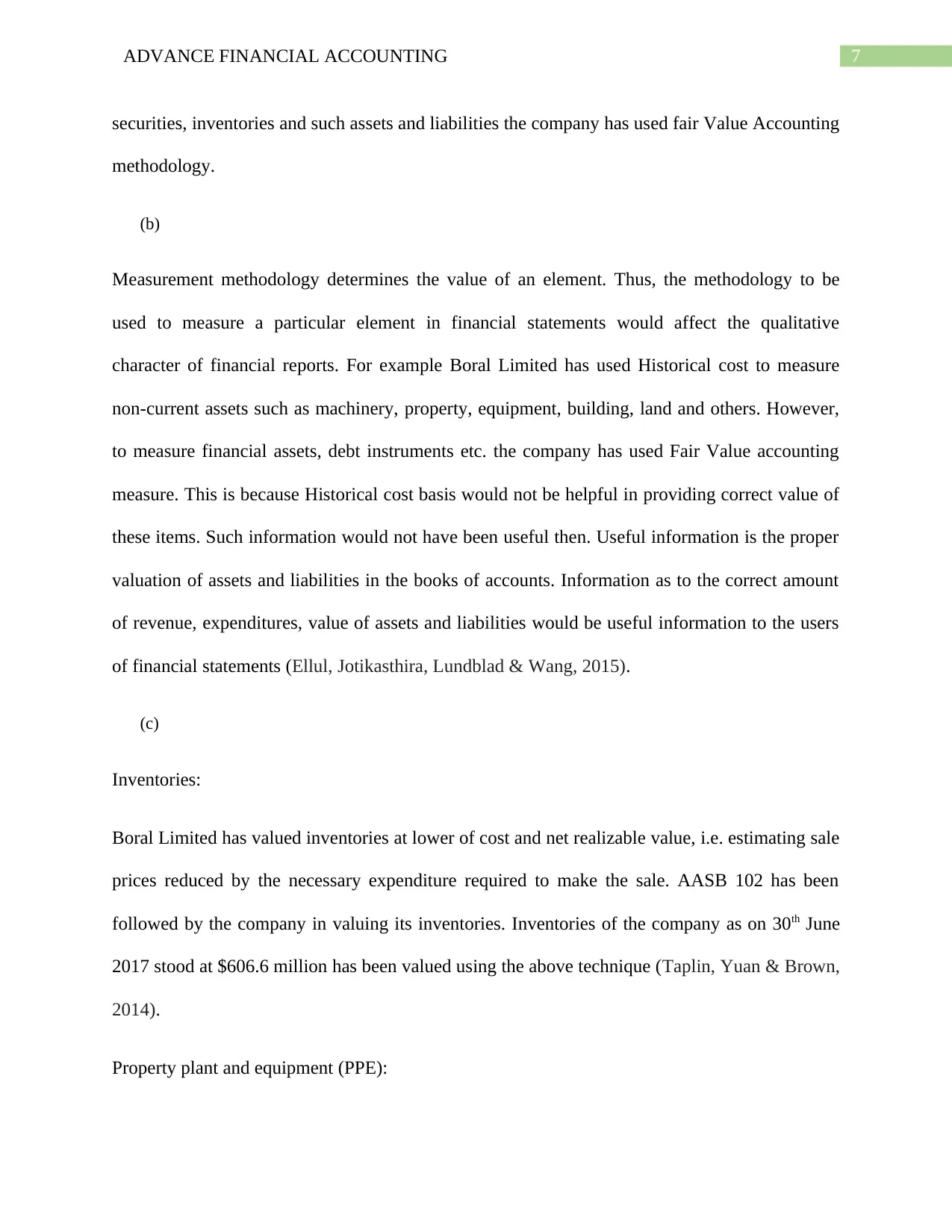
7ADVANCE FINANCIAL ACCOUNTING
securities, inventories and such assets and liabilities the company has used fair Value Accounting
methodology.
(b)
Measurement methodology determines the value of an element. Thus, the methodology to be
used to measure a particular element in financial statements would affect the qualitative
character of financial reports. For example Boral Limited has used Historical cost to measure
non-current assets such as machinery, property, equipment, building, land and others. However,
to measure financial assets, debt instruments etc. the company has used Fair Value accounting
measure. This is because Historical cost basis would not be helpful in providing correct value of
these items. Such information would not have been useful then. Useful information is the proper
valuation of assets and liabilities in the books of accounts. Information as to the correct amount
of revenue, expenditures, value of assets and liabilities would be useful information to the users
of financial statements (Ellul, Jotikasthira, Lundblad & Wang, 2015).
(c)
Inventories:
Boral Limited has valued inventories at lower of cost and net realizable value, i.e. estimating sale
prices reduced by the necessary expenditure required to make the sale. AASB 102 has been
followed by the company in valuing its inventories. Inventories of the company as on 30th June
2017 stood at $606.6 million has been valued using the above technique (Taplin, Yuan & Brown,
2014).
Property plant and equipment (PPE):
securities, inventories and such assets and liabilities the company has used fair Value Accounting
methodology.
(b)
Measurement methodology determines the value of an element. Thus, the methodology to be
used to measure a particular element in financial statements would affect the qualitative
character of financial reports. For example Boral Limited has used Historical cost to measure
non-current assets such as machinery, property, equipment, building, land and others. However,
to measure financial assets, debt instruments etc. the company has used Fair Value accounting
measure. This is because Historical cost basis would not be helpful in providing correct value of
these items. Such information would not have been useful then. Useful information is the proper
valuation of assets and liabilities in the books of accounts. Information as to the correct amount
of revenue, expenditures, value of assets and liabilities would be useful information to the users
of financial statements (Ellul, Jotikasthira, Lundblad & Wang, 2015).
(c)
Inventories:
Boral Limited has valued inventories at lower of cost and net realizable value, i.e. estimating sale
prices reduced by the necessary expenditure required to make the sale. AASB 102 has been
followed by the company in valuing its inventories. Inventories of the company as on 30th June
2017 stood at $606.6 million has been valued using the above technique (Taplin, Yuan & Brown,
2014).
Property plant and equipment (PPE):
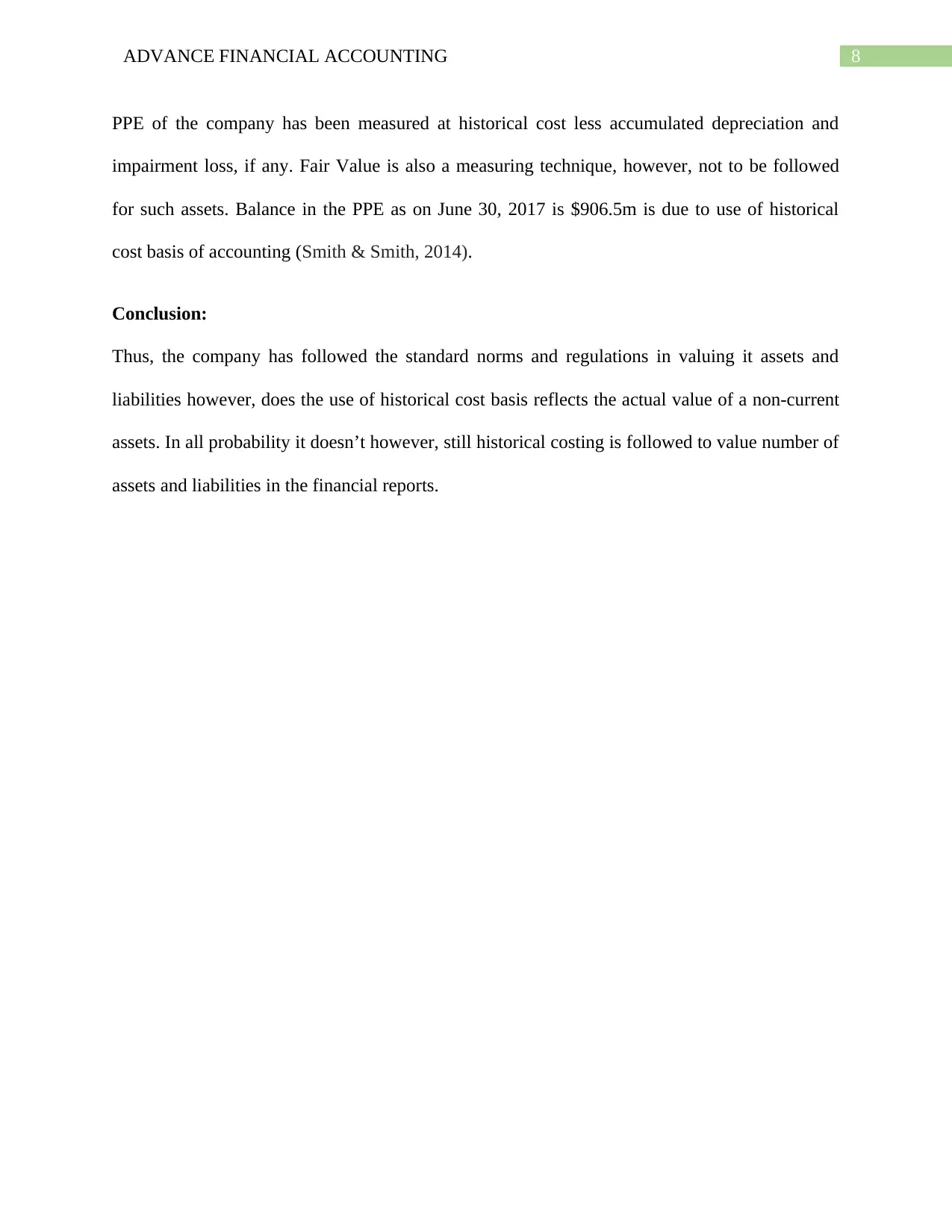
8ADVANCE FINANCIAL ACCOUNTING
PPE of the company has been measured at historical cost less accumulated depreciation and
impairment loss, if any. Fair Value is also a measuring technique, however, not to be followed
for such assets. Balance in the PPE as on June 30, 2017 is $906.5m is due to use of historical
cost basis of accounting (Smith & Smith, 2014).
Conclusion:
Thus, the company has followed the standard norms and regulations in valuing it assets and
liabilities however, does the use of historical cost basis reflects the actual value of a non-current
assets. In all probability it doesn’t however, still historical costing is followed to value number of
assets and liabilities in the financial reports.
PPE of the company has been measured at historical cost less accumulated depreciation and
impairment loss, if any. Fair Value is also a measuring technique, however, not to be followed
for such assets. Balance in the PPE as on June 30, 2017 is $906.5m is due to use of historical
cost basis of accounting (Smith & Smith, 2014).
Conclusion:
Thus, the company has followed the standard norms and regulations in valuing it assets and
liabilities however, does the use of historical cost basis reflects the actual value of a non-current
assets. In all probability it doesn’t however, still historical costing is followed to value number of
assets and liabilities in the financial reports.
⊘ This is a preview!⊘
Do you want full access?
Subscribe today to unlock all pages.

Trusted by 1+ million students worldwide
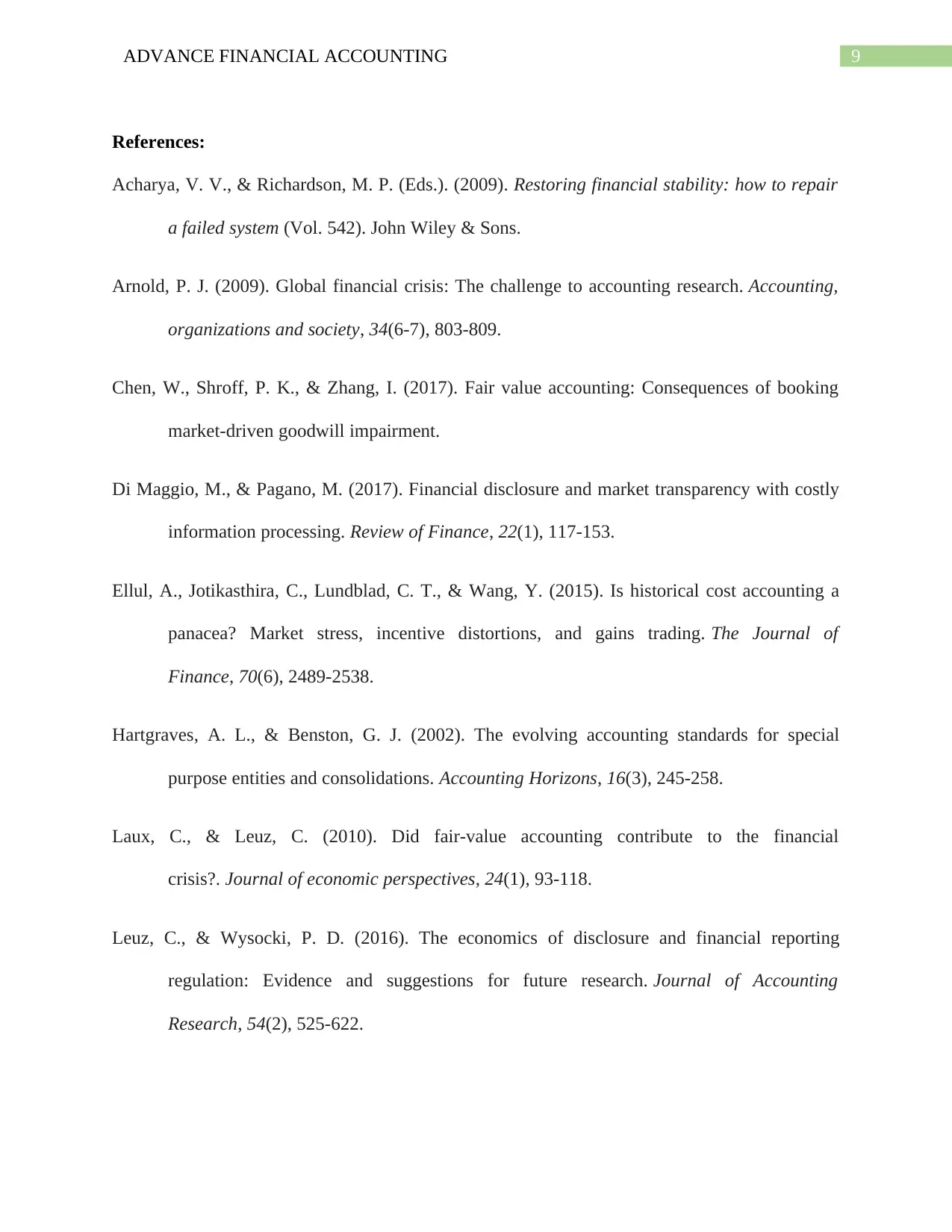
9ADVANCE FINANCIAL ACCOUNTING
References:
Acharya, V. V., & Richardson, M. P. (Eds.). (2009). Restoring financial stability: how to repair
a failed system (Vol. 542). John Wiley & Sons.
Arnold, P. J. (2009). Global financial crisis: The challenge to accounting research. Accounting,
organizations and society, 34(6-7), 803-809.
Chen, W., Shroff, P. K., & Zhang, I. (2017). Fair value accounting: Consequences of booking
market-driven goodwill impairment.
Di Maggio, M., & Pagano, M. (2017). Financial disclosure and market transparency with costly
information processing. Review of Finance, 22(1), 117-153.
Ellul, A., Jotikasthira, C., Lundblad, C. T., & Wang, Y. (2015). Is historical cost accounting a
panacea? Market stress, incentive distortions, and gains trading. The Journal of
Finance, 70(6), 2489-2538.
Hartgraves, A. L., & Benston, G. J. (2002). The evolving accounting standards for special
purpose entities and consolidations. Accounting Horizons, 16(3), 245-258.
Laux, C., & Leuz, C. (2010). Did fair-value accounting contribute to the financial
crisis?. Journal of economic perspectives, 24(1), 93-118.
Leuz, C., & Wysocki, P. D. (2016). The economics of disclosure and financial reporting
regulation: Evidence and suggestions for future research. Journal of Accounting
Research, 54(2), 525-622.
References:
Acharya, V. V., & Richardson, M. P. (Eds.). (2009). Restoring financial stability: how to repair
a failed system (Vol. 542). John Wiley & Sons.
Arnold, P. J. (2009). Global financial crisis: The challenge to accounting research. Accounting,
organizations and society, 34(6-7), 803-809.
Chen, W., Shroff, P. K., & Zhang, I. (2017). Fair value accounting: Consequences of booking
market-driven goodwill impairment.
Di Maggio, M., & Pagano, M. (2017). Financial disclosure and market transparency with costly
information processing. Review of Finance, 22(1), 117-153.
Ellul, A., Jotikasthira, C., Lundblad, C. T., & Wang, Y. (2015). Is historical cost accounting a
panacea? Market stress, incentive distortions, and gains trading. The Journal of
Finance, 70(6), 2489-2538.
Hartgraves, A. L., & Benston, G. J. (2002). The evolving accounting standards for special
purpose entities and consolidations. Accounting Horizons, 16(3), 245-258.
Laux, C., & Leuz, C. (2010). Did fair-value accounting contribute to the financial
crisis?. Journal of economic perspectives, 24(1), 93-118.
Leuz, C., & Wysocki, P. D. (2016). The economics of disclosure and financial reporting
regulation: Evidence and suggestions for future research. Journal of Accounting
Research, 54(2), 525-622.
Paraphrase This Document
Need a fresh take? Get an instant paraphrase of this document with our AI Paraphraser
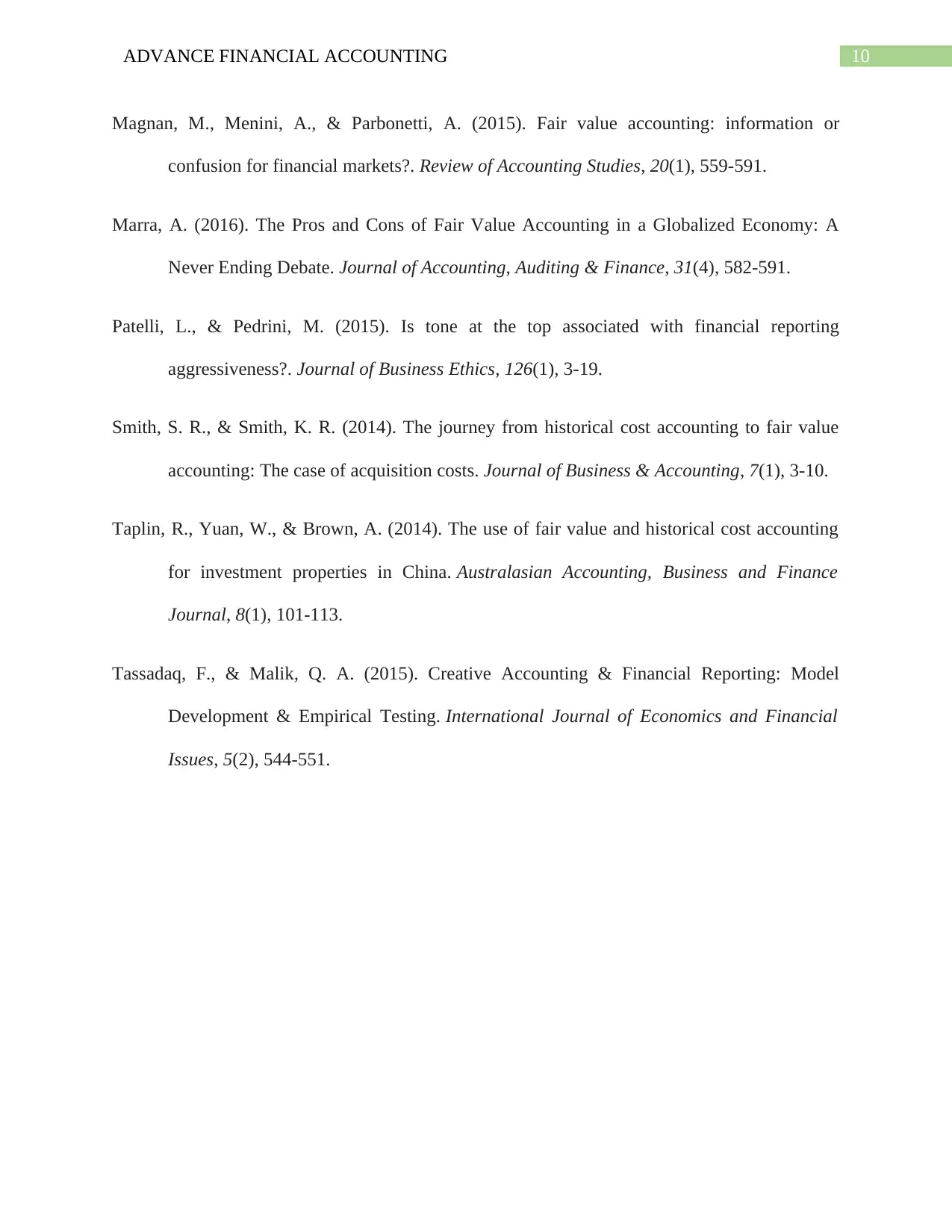
10ADVANCE FINANCIAL ACCOUNTING
Magnan, M., Menini, A., & Parbonetti, A. (2015). Fair value accounting: information or
confusion for financial markets?. Review of Accounting Studies, 20(1), 559-591.
Marra, A. (2016). The Pros and Cons of Fair Value Accounting in a Globalized Economy: A
Never Ending Debate. Journal of Accounting, Auditing & Finance, 31(4), 582-591.
Patelli, L., & Pedrini, M. (2015). Is tone at the top associated with financial reporting
aggressiveness?. Journal of Business Ethics, 126(1), 3-19.
Smith, S. R., & Smith, K. R. (2014). The journey from historical cost accounting to fair value
accounting: The case of acquisition costs. Journal of Business & Accounting, 7(1), 3-10.
Taplin, R., Yuan, W., & Brown, A. (2014). The use of fair value and historical cost accounting
for investment properties in China. Australasian Accounting, Business and Finance
Journal, 8(1), 101-113.
Tassadaq, F., & Malik, Q. A. (2015). Creative Accounting & Financial Reporting: Model
Development & Empirical Testing. International Journal of Economics and Financial
Issues, 5(2), 544-551.
Magnan, M., Menini, A., & Parbonetti, A. (2015). Fair value accounting: information or
confusion for financial markets?. Review of Accounting Studies, 20(1), 559-591.
Marra, A. (2016). The Pros and Cons of Fair Value Accounting in a Globalized Economy: A
Never Ending Debate. Journal of Accounting, Auditing & Finance, 31(4), 582-591.
Patelli, L., & Pedrini, M. (2015). Is tone at the top associated with financial reporting
aggressiveness?. Journal of Business Ethics, 126(1), 3-19.
Smith, S. R., & Smith, K. R. (2014). The journey from historical cost accounting to fair value
accounting: The case of acquisition costs. Journal of Business & Accounting, 7(1), 3-10.
Taplin, R., Yuan, W., & Brown, A. (2014). The use of fair value and historical cost accounting
for investment properties in China. Australasian Accounting, Business and Finance
Journal, 8(1), 101-113.
Tassadaq, F., & Malik, Q. A. (2015). Creative Accounting & Financial Reporting: Model
Development & Empirical Testing. International Journal of Economics and Financial
Issues, 5(2), 544-551.
1 out of 11
Related Documents
Your All-in-One AI-Powered Toolkit for Academic Success.
+13062052269
info@desklib.com
Available 24*7 on WhatsApp / Email
![[object Object]](/_next/static/media/star-bottom.7253800d.svg)
Unlock your academic potential
Copyright © 2020–2025 A2Z Services. All Rights Reserved. Developed and managed by ZUCOL.




